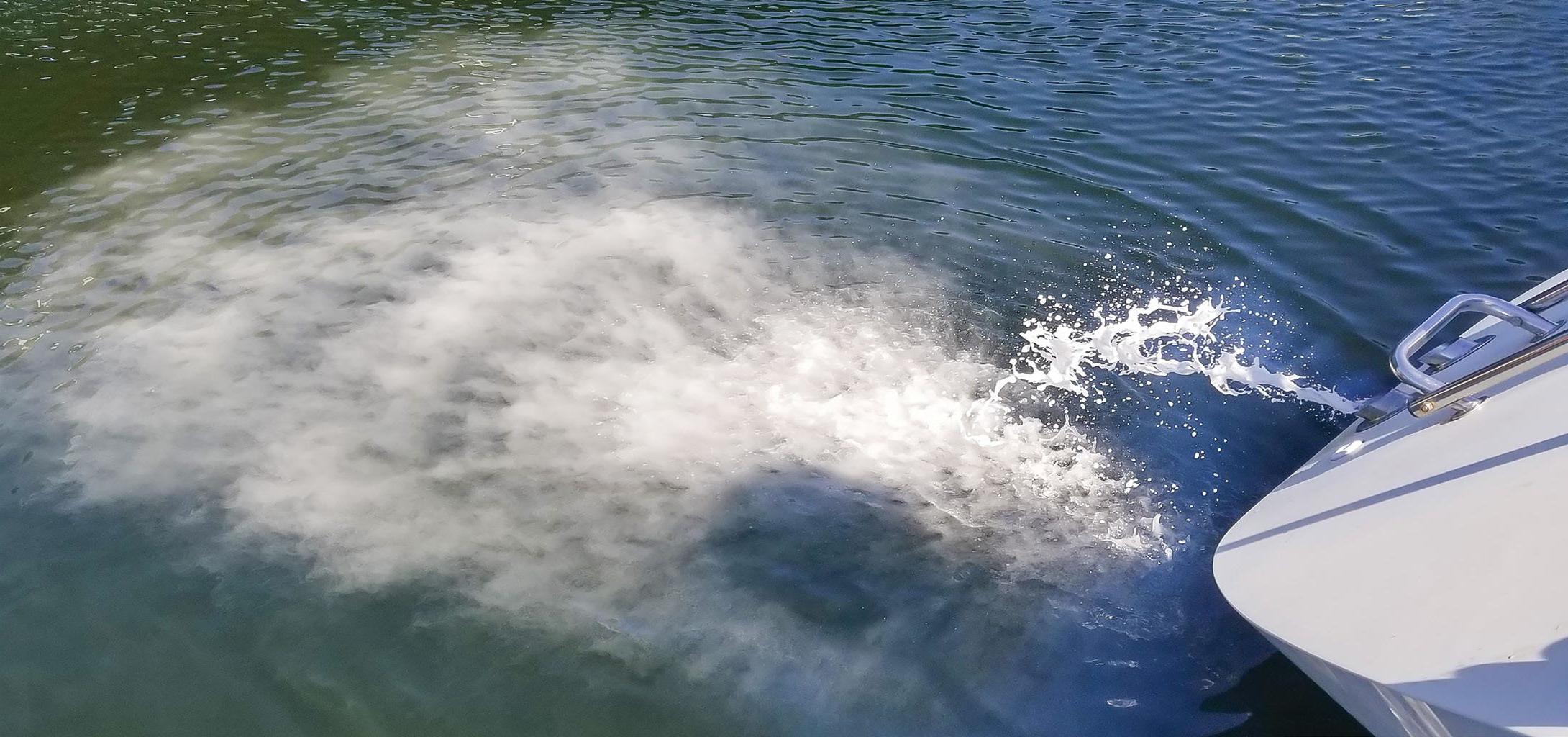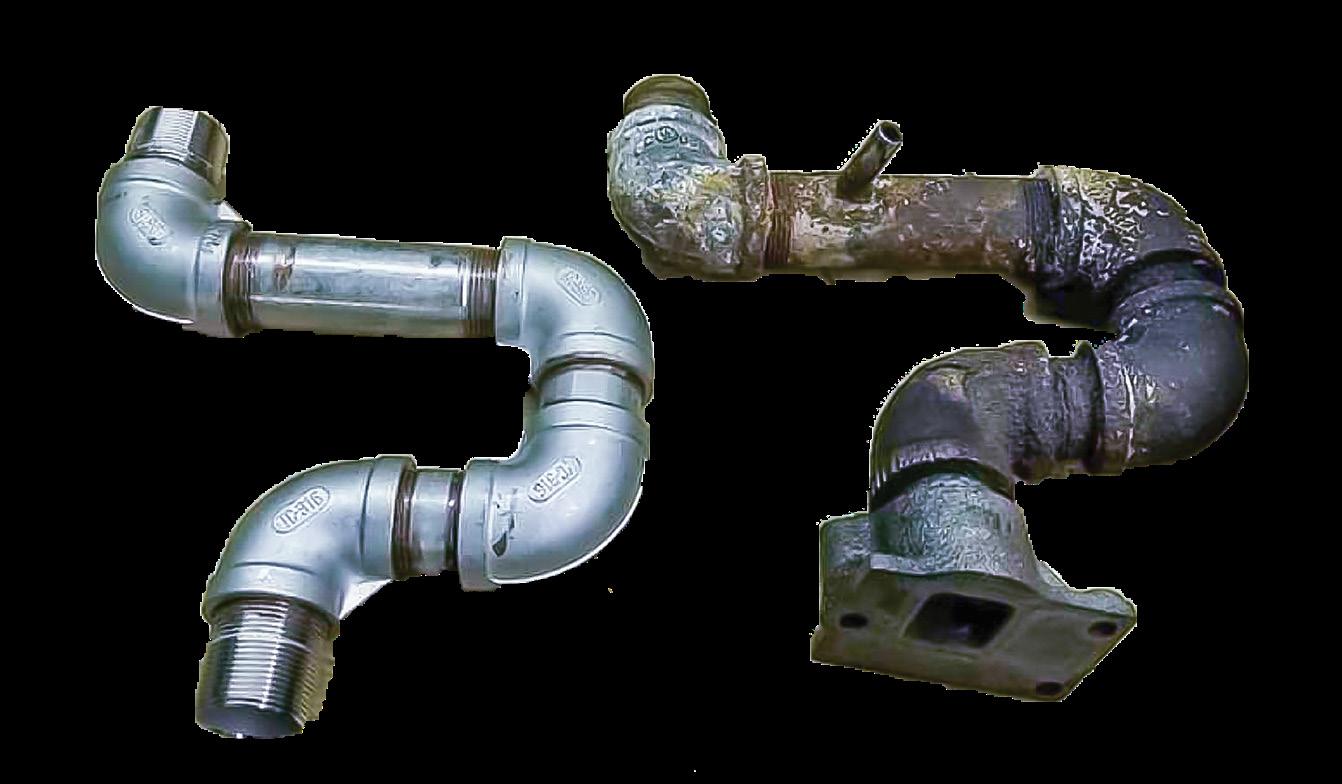
6 minute read
Diesel Deep Dive
from June 2021 48° North
by 48° North
24 Diesel Deep Dive
IS YOUR ENGINE SENDING SMOKE
SIGNALS?
by Meredith Anderson
In the 1890s, Rudolf Diesel created the first compression ignition oil-burning engine, and it was was large, heavy, smoky, and slow turning. While the general engineering behind today’s diesels hasn’t changed from the initial invention, a lot has evolved in terms of efficiency and performance. Today's diesels are significantly cleaner burning and are not the chugging smoke-machines we commonly think of when we think diesel.
The majority of diesel engines I see in recreational and commercial applications today range in age from approximately 60 years old to brand new. I have seen 60-yearold engines that are meticulously maintained showing almost no smoke, or none at all. Engines made within the last 20 to 30 years came off their manufacturing line running clean with little-to-no smoke.
As boaters and boat owners, consider smoke the result of something going on within the engine that needs to be addressed. It can be relatively benign, or extremely serious. Understanding what your exhaust is trying to tell you can help you stop a problem before it causes real damage, or at least it can help prevent problems in the future.
I once was called to work on a boat where both diesel engines had significant smoke coming out of their exhaust pipes — nothing crazy, but definitely noticeable. The vessel had a recent mechanical survey done and written in the survey were the words: “Smoke is normal for these engines.” I was appalled that a diesel mechanic would say that. It turns out the engines had several problems, but the biggest was that both had signs of multiple components beginning to fail. The mechanic had failed to see or honor this — perhaps this person thought all diesels smoke. In this oversight, the mechanic failed the customer, who purchased the vessel believing the engines were fine, when in fact they were not. It was a frustrating realization for the customer to discover how much work would be required. I left feeling terrible that such an obvious issue had gone overlooked.
Smoke from an engine tells quite a story, providing huge diagnostic clues to us mechanics as we try to figure out what is going on. Engines are very much like humans — they can have health issues just like we can. Medical professionals look, listen, and feel for clues to understand what is going on with their patient. It is no different with an engine. When performing an inspection on an engine, I look, listen, and feel for any abnormalities when the engine is running or not. I always get off the boat and watch the exhaust when

the engine is started up cold. I also check the exhaust again when the engine is warm, under load or not. By seeing the color(s) of smoke, I know exactly where to look from there. Is it injectors? Clogged exhaust elbow? Poor compression? Water in the engine? The exhaust smoke will tell me where to start saving me time and my customer money.
BLUE SMOKE
Blue smoke is a very common issue with marine diesels. Blue smoke can be several things but is most often burning oil. This means that engine oil is either making it into the cylinders or into the hot exhaust manifold/exhaust ports of the cylinder head. On a naturally aspirated engine, there are only a few areas where this can happen: valve stem seals or piston rings.
Most recreational engines have relatively low hours, so while piston ring wear is definitely possible, it’s not nearly as likely as valve stem seals. Oil getting through valve stem seals is a common issue that is benign, as long as it doesn’t become a severe leak. If a valve stem seal blows completely, you would see solid engine oil actually pouring out of the exhaust into the water and at that point, it needs to be addressed no matter what! Worn piston rings become more common if the engine is poorly maintained, idled a lot with little or no load, or has high hours. If your piston rings are worn, an engine rebuild is inevitable.
On forced air induction engines, burning oil can be a potentially serious issue as items like turbos and blowers (on Detroit 2-stroke engines) can be leaking oil into the air intake or exhaust side. Oil leaking into the air intake from a blower, supercharger, or turbo can be a serious issue as it can be potential for a runaway situation. A runaway engine that is burning engine oil is just like it sounds: it can’t be stopped by pushing the STOP button on the panel. It will either come to a violent stop by breaking something or seizing once engine oil is gone. The only safe way to shut the engine down is to plug the intake with a book, close the damper (on a roots style blower) or snuff it out with a Co2 fire extinguisher. None of us want that to happen! If you see lots of blue smoke and your engine has forced air induction – check those items and address them first.

WHITE SMOKE
White smoke is something no boat owner wants to see, as it can be a sign that water has entered the combustion chamber or hot exhaust. The culprits? Most often, the wet exhaust mixing elbow is to blame, particularly on smaller sailboat engines with elbows that aren’t made of stainless steel. Yanmar and Volvo’s mixing elbows have a particularly poor design, they almost always look fine on the outside but can be rotted out on the inside, allowing water to go backwards into the engine via the exhaust manifold. If the exhaust plumbing is improperly installed with its outlet high above the engine and no water-lock muffler, the engine can also hydro-lock as water drains back into the exhaust manifold. Water can’t be compressed, so if enough of it makes it into a cylinder, the piston or connecting rod will bend or break. Another issue that produces white smoke is a blown head gasket, where coolant enters the combustion chamber. This is actually less common — except for raw water engines — unless the engine has been severely overheated, the gasket was installed improperly, or it is just worn out. For raw water engines, cracks in the block and head can form over time from normal wear, as raw water engines weren’t designed to last nearly as long as their freshwater counterparts.

GRAY/BLACK SMOKE
Gray, or even black smoke is most often a sign of poor or incomplete combustion. Look closely, because grey smoke can appear almost white, when it is in fact gray and signaling something different than white smoke does. Look for this light gray smoke especially when cranking over a cold engine that may not want to start.
Failing, dirty, or broken injectors will cause all kinds of gray/black smoke. Injector nozzles are tiny – designed to atomize diesel in a broad pattern as it enters the combustion chamber. If a nozzle is partially blocked, dripping, or the injector is not “popping off” at the right pressure — you will see grayish black smoke during operation or initial startup. Dripping injectors can burn pistons and valves; so if it’s bad enough, then injectors should be serviced or replaced. A clogged air cleaner can also cause grayish black smoke as the engine is starving for air, causing poor combustion.
This is a fairly narrow spectrum of what all can happen when you see smoke, but I hope it provides a reminder to pay attention to your exhaust because it tells you a story. A lot of smoke I see is harmless for a period of time — but if the problem goes neglected, it can grow to be an expensive problem down the road. Listen to your engine when it’s sending you smoke signals! It will save you in the long run.
Meredith Anderson is the owner of Meredith’s Marine Services, where she operates a mobile mechanic service and teaches hands-on marine diesel classes to groups and in private classes aboard their own vessels.






